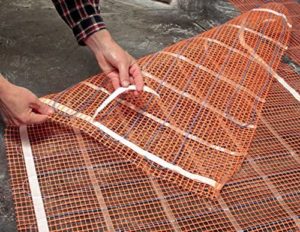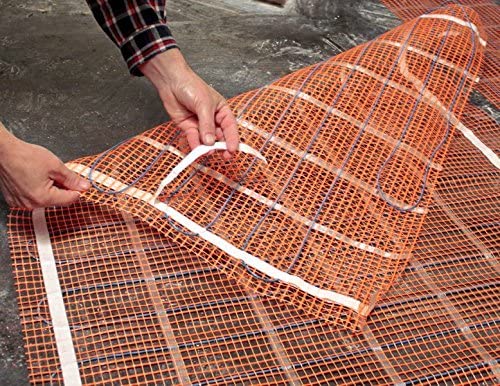This post may contain affiliate links which means I may receive a commission for purchases made through links.

When installing an electric radiant floor heating system in your home, it’s important to ensure your calculations are correct before you buy an electric mat. If possible, look for a UFH heating mat that matches the dimensions and shape of your property. This will allow you to get maximum floor coverage and reduce your chances of cutting or damaging the mat. What if the mat is bigger than the room you’re installing it in? Can you cut an underfloor heating mat? Well, continue reading this article on how to install an electric heating mat to find out!
How to install an electric underfloor heating mat
There are various techniques you can use when installing radiant floor heating mats in your home. To accomplish this, you’ll need to cut the fiberglass mesh that holds the heating wire in place. But before we get there, let’s look at some of the items you’ll need for the project;
What you’ll need
- Electric underfloor heating mat
- A 2.5m long flexible conduit terminated with a rubber stopper at one end
- A 1.5m long flexible conduit
- Floor sensor & Temperature control (underfloor heating thermostat)
- cutters/ scissors
- Multimeter (Ohmmeter)
- Tools for cutting chases in floors & walls
Electric radiant floor heat mat installation
1. Choose the appropriate electric heating mat
Accurately measure the actual floor area of the room you intend to install the electric mat. And calculate the available heat area by deducting areas that cannot be heated like Baths, kitchen units, shower trays, and toilets.
Next, choose the best electric underfloor heating mat that will perfectly fit within your open heating area. Basically, the appropriate heating mat kit should be about 10% smaller compared to the open floor area. Also, the selected heating mat should be ideal for use on the type of floor finish in your home.
2. Testing
Use a multimeter to test the insulation’s resistance to the mat’s electric cable. If the multimeter has a voltage rating of 1000V, the heating mat’s resistance shouldn’t be below 10 Ohms. Also, do a resistance test for the electric heating mat after completing the insulation’s resistance test and enter the results into your warranty card. Overall, you should test the heating mat after unpacking, before & after installing, and after laying the adhesive on the floor finish.
3. Prepare the floor surface
Before you start installing the mat, make sure that the sub-floor surface is clean, dust-free, and dry. If the sub-floor is made up of wood, check if it’s stable and reinforce it if it’s not to prevent dislodging and flexing.
Secondly, use an acrylic adhesive to prime the floor to cover the entire area of insulation or screed. Leave the primer to dry as you prepare to install an insulation board.
4. Lay an appropriate insulation material
Install an appropriate insulation board on the floor where you intend to heat with the electric heating mat. In essence, the insulation material should cover the entire floor area you’re planning to lay tiles or laminate flooring. If you’re using an XPS premium insulation board, stagger them according to the manufacturer’s instructions. In addition, use a strong adhesive to secure the boards to the sub-floor surface.
5. Installation
Carefully study the floor plan and choose the ideal location to start the circuit and where to install the UFH thermostat and floor sensor. Also, make sure you read all instructions and instruction guides from the manufacturer before you start your installation. And as I mentioned earlier, test all cables and heating mats before installation to ensure the test readings match the theoretical readings at the back of the guide.
Once you’ve done that, start installing the electric mat from the area of your thermostat. Roll out the electric mat and secure it to the floor surface by revoking the self-adhesive backing on its mesh. If the adhesive isn’t strong enough, use tape to secure the mat, keeping it 50 – 100 mm away from the wall. More importantly, in areas that are hard to lay the mat such as around the bath or toilet, you can take the heating cable off the mat.
6. Cut the mesh
Cut the mesh when you reach the end of the room. So, to answer your question; yes, you can cut the mesh of an electric heating mat. However, you should NEVER cut or shorten the heating cable as it will result in failure and even invalidate your warranty.
So, if you’ve too much floor heating cable than you anticipated, look for alternative options like adjusting the spacing of the wires on the mat. Just make sure that the wires are not spaced closer than 50mm.
That aside, after cutting the mesh, rotate the heating mat 180 deg to make another run until you reach the other end of the room. And if you’re changing direction, turn the heating mat 90 deg, flip it over and continue.
7. Check the cable’s resistance & insulation cables
After laying the mat, test the cable’s resistance again to see if it’s consistent with the pre-insulated values and indicate it on the guarantee certificate. Using a screwdriver, upgrade the cold tail connection (black lead) and pull down the braid into separate strands. Next, use the earth terminal in the black box to connect the earth to the incoming supply.
8. Monitor the temperature of the electric heating mat
Cut out a section of the insulation large enough to fit the black conduit. Install a floor sensor in between 2 runs of the heating cable to allow the best reading. Put the sensor inside the conduit and place it into the hole you had cut out earlier. If necessary, you can cut the end of the floor sensor with open wires to shorten it. However, you should not cut the end with the plastic sensor. Now, use the floor sensor to monitor the temperature of the heating mat. Lastly, do a final test on the heating mat by using the multimeter to check the cable resistance and insulation resistance.
9. Cover the heating mat with the flooring material
Although this is not mandatory, it’s recommended that you apply a leveling compound over the heating before you lay the final floor finish. For instance, you can cover the heating cables with a thin layer of a suitable latex-based compound to protect the mat.
Now, lay your floor finish over the leveling compound in accordance with the manufacturer’s guidelines and industry standards. Once you’ve done that, slowly turn on the heating and increase its temperature over a few days before you set it to your desired settings.
Conclusion; Can you cut an electric underfloor heating mat?
To sum up, the heating cable of an electric mat should NOT be cut, extended, shortened, or left in a void for any reason. However, you can cut the fiberglass mesh and shorten the cold tails, if necessary. For safety reasons, it’s recommended that any electrical installation work be performed by a qualified electrician. More importantly, the electric underfloor heating system should have appropriate circuit protection, including a suitably rated fuse and an RCD.
